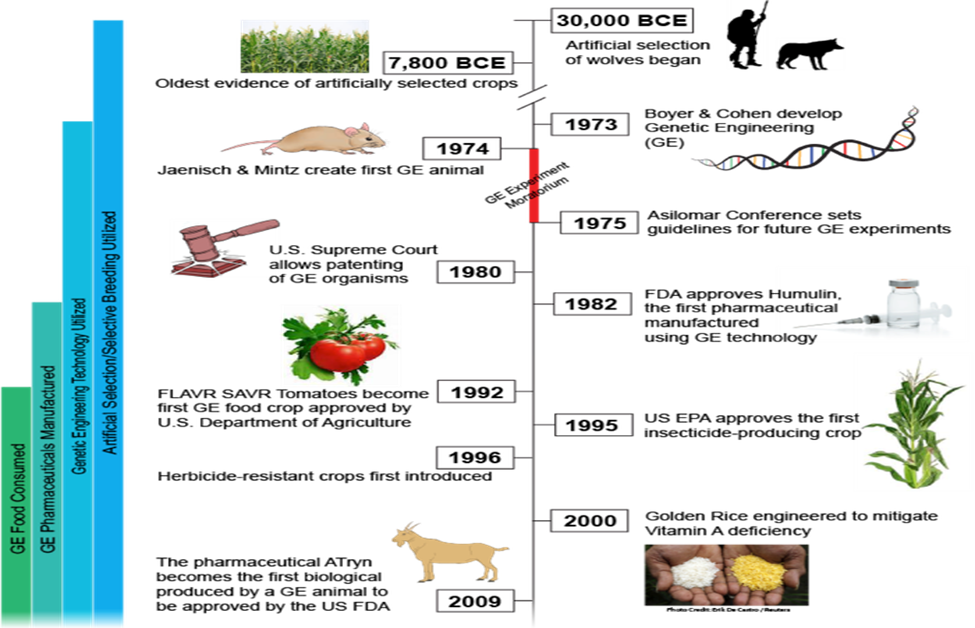Historical Timeline and Predecessor
The domestication of plant and animals is indeed miraculous, and in our present century has increasingly shown how control of animals and plants for the development of agriculture served as catalyst for the emergence of Genetically Engineered Organisms (GMO’s). What makes agriculture miraculous is how unlikely the process was, and the fact that it occurred independently in different geographical areas of the world. From the fertile Crescent of Near East almost 10,000 years ago to Sub-Saharan Africa and the United States over 4,000 years ago, agriculture has transformed human food supply from one of adequacy to sufficiency and will continue to have an indelible mark on the landscape of history. Genetically modified organisms have changed farming practices seemingly overnight in the United States and have driven sustainable agriculture and organic farming practices to new heights. The GMO timeline is depicted in the diagram below.

Gathering of Animals
The timeline began over 32,000 years ago when our ancestors were hunters and gatherers, and during hunting expeditions were frequently joined by wild wolves as scavengers seeking refuse from kills. These scavengers were domesticated and artificially selected to increase docility eventually leading to dogs. Over centuries varying traits such as hair color and length, size, and body shape were artificially selected to alter genetics and produce other domesticated descendants.
Discovery of Agriculture
Beginning over 30,000 years ago our ancestors although lacking scientific laboratories, manipulate plant and animal genes through selective breeding, or artificial selection, choosing organisms with the most desired traits, and mating them with the purpose of combining traits to propagate a desired effect, in a better and more productive specie through their offspring. The impact was evident over many generations resulting in impressive genetic changes to many species. Artificial selection is not considered GMO technology compared to the science of today but is precursor to the modern processes of early genetic influences on the species. Historical records showed evidence that around 7,800 BC, plants were artificially selected for crops to improve food production and sustenance.
The Discovery of Genes and Isolation of DNA
Gregory Mendel in 1865 build on the work of Charles Darwin to discover that heredity was transmitted in units later leading to the isolation of DNA by Frederick Meischer (1869). Between 1953 when Francis H. Crick and James D. Watson describe the double helix structure of DNA, and 1968 when Steward Linn and Werner Arber described the first restrictive enzymes, many scientists contributed to the development of DNA cloning and discovery of the first human genetic map, and in 2003 the human genome was completed. A study by Zang C. (2016) discussed the progress of GMOs from the ideas of Darwin to its impact on today’s societies.

Break-through in GMO Technology
The discovery of plant and animal genes and DNA technology led the revolution that provided impetus to techniques and methodologies to produce hybrids through sorting and selection processes and the science of genetically altered DNA material to increase the frequency of mutation over and above the natural levels. This came in 1973 when Herbert Boyer and Stanley Cohen collaborated to engineer the first successful genetically engineered (GE) organism. According to Plech, M. et al (2017), an understanding of the effects of mutation in the evolutionary process is aided by the pioneering work of Charles Darwin (1859) evolutionary insight, and framework for the survival of species. Darwin’s thoughts and ideas has indeed shaped the GMO landscape to what it is today.
While the use of genetic engineering has provided impactful solutions for disasters, medicinal breakthroughs, pest and disease control, the most controversial application is for food production and consumption by humans. In looking at the timelines pertinent to GMO’s history and development it is central to understand how the prevailing theories and application of techniques and methods of plant and animal survival rest with what was coined by Darwin as “the fittest of the fittest” to survive by producing a more robust species. At each juncture in time, successive generation have built on the foundation and technology of early GMO application left by our predecessors. Komparic, A. (2016) points to the contentious nature of DNA, and the prevalence of anti-GMO sentiments in Africa and across the globe. It is safe to say the knowledge, application, and understanding of GMO’s technology will shape the future of human consumption of goods and services, while serving as an imperative for solutions to problems in industries such as; agriculture, medicine, animal food supplies, and even bio-weaponry. The impact will be profound and long-lasting.

14 thoughts on “GMOs: Art of Duplicating”
Your site is amazing. It is fast as well as kudos with respect to permitting reviews.
Your web site is profoundly important to your guests. Kudos for posting, kudos with respect to the numerous area of interests.
What’s Going down i am new to this, I stumbled upon this I’ve found It absolutely useful and it has helped me out loads. I’m hoping to give a contribution & aid different users like its helped me. Great job.
Howdy I am so excited I found your blog, I really found you by error, while I was browsing on Askjeeve for something else, Nonetheless I am here now and would just like to say thanks for a remarkable post and a all round exciting blog (I also love the theme/design), I dont have time to read it all at the moment but I have bookmarked it and also included your RSS feeds, so when I have time I will be back to read a lot more, Please do keep up the fantastic work.
Thanks for all your valuable effort on this web page. My aunt take interest in engaging in investigation and it’s simple to grasp why. We hear all relating to the compelling ways you produce useful things by means of this website and in addition attract participation from some others on that concern and our favorite daughter has been discovering so much. Take pleasure in the remaining portion of the new year. Your performing a dazzling job.
I wanted to compose a small word so as to express gratitude to you for all of the great strategies you are posting on this site. My extended internet look up has now been compensated with brilliant details to go over with my great friends. I ‘d suppose that many of us visitors actually are rather fortunate to be in a useful website with so many brilliant people with good principles. I feel very happy to have discovered the web page and look forward to really more enjoyable moments reading here. Thank you again for a lot of things.
Good day! This post could not be written any better! Reading this post reminds me of my old room mate! He always kept talking about this. I will forward this write-up to him. Fairly certain he will have a good read. Thank you for sharing!
I wish to show my respect for your kind-heartedness for people that have the need for guidance on your niche. Your real commitment to getting the solution all around came to be pretty good and have regularly allowed workers like me to achieve their desired goals. Your informative instruction implies this much to me and far more to my peers. Best wishes; from everyone of us.
Thanks so much for providing individuals with an extremely terrific chance to read from this website. It’s always so great and also packed with amusement for me and my office colleagues to visit your web site at the least three times per week to find out the fresh issues you will have. And indeed, I am also always satisfied considering the gorgeous secrets you give. Certain 4 areas in this post are really the simplest we’ve ever had.
Super-Duper website! I am loving it!! Will be back later to read some more. I am bookmarking your feeds also.
I really wanted to write a small message to be able to say thanks to you for all of the nice guides you are giving on this site. My time intensive internet research has finally been paid with high-quality concept to write about with my neighbours. I ‘d believe that many of us website visitors actually are undeniably endowed to live in a magnificent site with many special individuals with very helpful secrets. I feel very much blessed to have come across the web page and look forward to some more exciting times reading here. Thanks a lot once more for everything.
An intriguing discussion is worth comment. I do think that you should publish more on this topic, it might not be a taboo subject but generally people dont speak about such subjects. To the next! Cheers!!
Normally I do not read article on blogs however I would like to say that this writeup very forced me to try and do so Your writing style has been amazed me Thanks quite great post
I was recommended this website by my cousin I am not sure whether this post is written by him as nobody else know such detailed about my difficulty You are wonderful Thanks